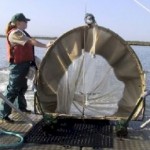Delta Smelt Numbers “improve” as Pumps Kill Millions of Splittail
By Dan Bacher
 Department of Fish and Game (DFG) officials announced on July 20 that young Delta smelt abundance this year roughly doubles that of last year, but noted that this is “but a small fraction of their historical abundance.”
Department of Fish and Game (DFG) officials announced on July 20 that young Delta smelt abundance this year roughly doubles that of last year, but noted that this is “but a small fraction of their historical abundance.”
“The improvement is likely due in large part to higher than usual flows from the San Joaquin and Sacramento rivers this year that resulted in better habitat conditions and water quality,” according to a DFG news release.
The announcement of “improved” Delta smelt numbers was issued as one of the greatest fish kills in California history continues to take place in the state and federal Delta pumps.
A horrific total of 8,942,347 splittail, 35,435 chinook salmon, 385,392 striped bass, 49,812 largemouth bass, 67,383 bluegill, 66,403 white catfish, 20,178 channel catfish, 91,956 threadfin shad, 166,336 American shad, 1,642 steelhead and 51 Delta smelt were “salvaged” in the state and federal water export facilities from January 1 to July 21, 2011, according to DFG data.
The overall loss of fish in and around the State Water Project and Central Valley Project facilities is believed to dwarf the actual salvage counts, according to “A Review of Delta Fish Population Losses from Pumping Operations in the Sacramento-San Joaquin River Delta,” prepared by Larry Walker Associates in January 2010 for the Sacramento Regional County Sanitation District (http://www.srcsd.com/pdf/dd/fishlosses.pdf).
Delta water exports may reach a record high!
The massive loss of fish life in the “predatory” pumps occurs as the pumps are currently exporting record amounts of water to corporate agribusiness and southern California.
“Exports from the Bay-Delta may reach an all-time high in 2011,” according to Spreck Rosecrans, an economic analyst at Environmental Defense (http://blogs.edf.org/waterfront/2011/07/15/delta-exports-projected-to-reach-record-level-in-2011/). “Through July 15, pumping for the State Water Project and the Central Valley Project has totaled 4.86 million acre-feet. With ample supplies in northern reservoirs and Sierra rivers still full of melting snow, it is likely that the pumps will continue to run at or near capacity through the end of the water year (September 30).”
The annual export total is projected to reach 6,610,000 acre-feet; 140,000 acre-feet more than the previous record of 6,470,000 acre-feet set in 2005, Rosecrans noted.
“The record export level is expected even though pumping levels were reduced not only during much of the winter and spring to protect salmon and other endangered fish but also in the late fall and early winter due to mechanical problems at State Water Project facilities,” said Rosecranz.
At the same time, Metropolitan Water District of Southern California is wholesaling water at discount prices, since southern California reservoirs have largely filled (http://www.pe.com/localnews/stories/PE_News_Local_D_surplus11.3abcf4c.html). So all of these fish are dying – even though southern California is flush with water this year!
Delta smelt are still on the verge of extinction
As massive amounts of water continue to be exported from the Delta, the Delta smelt are still in great peril, in spite of this being a wet year.
The 20-Millimeter Survey “index” of young Delta smelt abundance, developed yearly since 1995 and named after the approximate size of fish it collects, was 8.0 this year. By comparison, the index in 2010 was 3.8 and its record high was 39.7 in 1999.
The Summer Tow Net Survey index of slightly-older Delta smelt abundance, developed yearly since 1959 and named after the type of net used to collect fish, was 2.2 this year while the index in 2010 was 0.8 and the record high was 62.5 in 1978.
“The increased number of young Delta smelt is encouraging, but because it is still early in their one-year life cycle, the abundance of adults may or may not increase similarly,” according to Marty Gingras, DFG Supervising Biologist. “DFG will continue to monitor the population and at the conclusion of the Fall Midwater Trawl Survey in December will calculate and then release an index of sub-adult Delta smelt abundance.”
Because it is exceptionally difficult to determine the actual number of Delta smelt, Department of Fish and Game (DFG) biologists use survey data to develop “indices” of the species abundance. An index is a number that is likely to vary in direct proportion to abundance.
For example, if a hypothetical index were to double from 4 to 8 then abundance would also have doubled (e.g., from 200,000 to 400,000).
Smelt collapse part of a larger decline
Delta smelt are an indicator species that occur only in the Sacramento-San Joaquin River Delta. The finger-sized fish was historically one of the most abundant in the Delta. However, the species declined substantially, due to massive exports of water to agribusiness and southern California and other factors, and was listed as “threatened” under the California and Federal Endangered Species acts (ESA) in 1993.
after a further decline, the species was designated as “endangered” in 2010 under the California ESA.
The collapse of Delta smelt occurs in the context of the Pelagic Organism Decline (POD). Since 2005, state and federal scientists have documented the alarming decline of pelagic (open water) species including Delta smelt, longfin smelt, threadfin shad and young striped bass. Factors behind the decline include increases in water exports, toxics, invasive species and ammonia pollution from sewage treatment plants.
“The state and federal governments had the opportunity this year to reverse the decline of Central Valley salmon and Delta fish species,” said Bill Jennings, executive director/chairman of the California Sportfishing Protection Alliance (CSPA). “But what they are doing now is minimizing the rebound of fisheries that occurs in a wet year by pumping water at the maximum rate. The fish ‘salvage’ numbers are just the tip of the iceberg of the fish that are lost in the state and federal pumps.”
Rather than taking long-needed action to stop the carnage at the water export facilities, the Brown and Obama administrations, in the foot steps of the Schwarzenegger administration, are instead pushing for the construction of a peripheral canal or tunnel through the Bay Delta Conservation Plan (BDCP) to facilitate the export of more northern California to corporate agribusiness on the west side of the San Joaquin Valley and southern California water agencies.
For more information, go to: http://www.dfg.ca.gov/delta/data/townet/indices.asp?species=3and http://nrm.dfg.ca.gov/FileHandler.ashx?DocumentID=34731.
